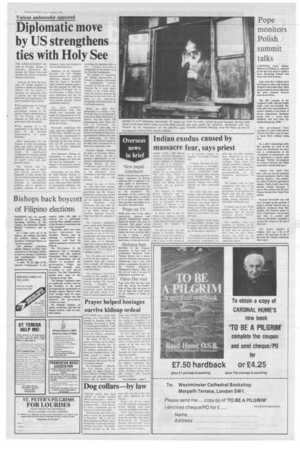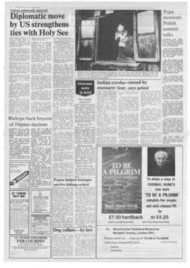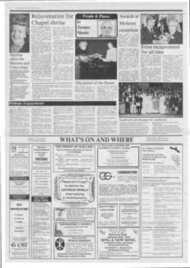Page 2, 13th January 1984
Page 2

Report an error
Noticed an error on this page?If you've noticed an error in this article please click here to report it.
Tags
Share
Related articles
Us Envoy For Holy See
Century-old Breach Healed
Us Set To Send
Vatican Visit By Us President After Madrid 'exclusion' Row
Vatican Restores Links With Poland
Diplomatic move by US strengthens ties with Holy See
THE ANNOUNCEMENT this week by President Reagan to formalise diplomatic ties between the United States and the Holy See further strengthens already existing links.
Although the Holy See never takes the formal initiative to establish or break off diplomatic relations with any country, it welcomes new diplomatic links in general and will welcome them with the United States. The most immediate effects will be: • The appointment of a Vatican ambassador to the US government instead of the current Vatican representative to 0 the US Church, who can represent the Holy See to the government only informally; • The naming of a US ambassador to the Holy See in place of the personal representative of recent Presidents.
More importantly for the Vatican, its work of promoting peace and justice through its worldwide diplomatic network
would be significantly strengthened by having a formal diplomatic post in the capital of the world's richest and most powerful nation.
The Vatican uses its diplomacy not only to watch over Church interests but frequently to help smooth the way for international aid during disasters, to seek peaceful solutions to international conflicts, and in general to promote concerns of justice. humanity, peace and morality in the international arena.
Rumours of an imminent decision by the Reagan administration to establish diplomatic relations with the Holy See began in November when President Reagan signed a bill that repealed the 1867 ban on formal US-Vatican ties. In mid-December a White House press spokesman said that the administration and the Vatican "are certainly moving" toward establishing relations.
The move formalises communications links that already exist informally and makes the representatives of the two states an integral part of the diplomatic corps in Washington and at the Vatican.
Previously Archbishop Pio Laehi. apostolic delegate in the United States, officially was only the Holy See's representative to the US Catholic Church. Informally he also had contacts with the US government and with the foreign diplomatic corps in Washington.
Now diplomatic relations are established, in place of an apostolic delegate the Holy See will have an ambassador — a Nuncio or Pronuncio in Vatican parlance — to the United States.
Conceivably, but not likely, he could become Nuncio, or automatic dean and chief spokesman of the diplomatic corps, following a long tradition in international diplomacy that allows nations a choice of according the deanship either to the longest-accredited ambassador in the country or to the Holy See's ambassador.
The practice of recognising the Vatican representative as Nuncio is common particularly in traditionally Catholic countries of Europe and Latin America, but it seems highly unlikely in the United States, where the seniority protocol has long seen in peace and where the issue of any diplomatic recognition of the Holy See at all is politically sensitive.
When the Holy See's ambassador to a country is not automatic dean of the diplomatic corps, he is called a Pronuncio, a position that also carries full ambassadorial rank, Since the title of Pronuncio was established 15 years ago, the Holy See has ceased its former practice of naming Internuncios, representatives without the rank of ambassador, to those countries that did not recognize the Holy See's representative as dean of the diplomatic corps.
President Reagan, following the policy of Presidents Nixon, Ford and Carter, has had a personal representative to the Vatican, California businessman William Wilson. As with Archbishop Laghi in the United States, however, Wilson's links to the diplomatic corps accredited to the Holy See have been — until now — only informal.
Despite the lack of formal ties, there have been frequent communications between the US government and the Vatican. Diplomatic pouches have carried letters between the White House and the Apostolic Palace, and every President since Eisenhower has met with the Pope. In November Reagan met in the White House with Cardinal Agostino Casaroli, Pope John Paul ti's secretary of state.
The Vatican's diplomatic, corps, which staffs Nunciatures in more than 100 countries around the world, has long had a reputation as one of the most professional and best-informed diplomatic networks in the world. Most of its diplomats begin their training shortly after ordination with studies at the Pontifical Ecclesiastical Academy in Rome.
Four US priests are currently studying at the academy — a departure from past tradition when virtually all diplomatic trainees were from Europe and most were Italian.
The increased non-Italian presence at the academy is in response to calls by the world's bishops during the Second Vatican Council to internationalise the Italiandominated papal diplomatic corps and other offices of the Church's central administration.
blog comments powered by Disqus











